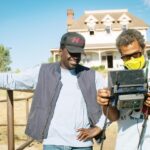As comic book fans descend on Southern California this year for the return of San Diego Comic-Con, the stage might be set for announcing the future of the Wonder Woman film franchise, with star Gal Gadot and director Patti Jenkins reuniting to close out the trilogy that started with their 2017 blockbuster. But before Gadot assumed the mantle of Wonder Woman in Zack Snyder’s 2016 universe-expanding team-up, Batman v. Superman: Dawn of Justice, the DC Comics hero nearly had another live action origin story.
In 2011, Friday Night Lights star Adrianne Palicki played the Amazonian warrior in a never-aired pilot for an NBC TV series overseen by superstar producer David E. Kelley. The show arrived at a crucial pivot point for DC’s television ambitions: Smallville had just finished its 10-year run on The CW (formerly The WB) and Arrow was still a year away from launching the youth-oriented network’s ongoing Arrowverse.
Had it gone forward, Wonder Woman would have been DC’s most high-profile primetime superhero drama since The Flash and Lois & Clark nearly two decades earlier. It was also poised to be the title character’s first live action incarnation since Lynda Carter’s much-loved ’70s TV series, and followed years of failed attempts to bring the character — who made her comic book debut in 1941 — to the big screen. Instead, the pilot wound up being a fascinating Elseworlds one-shot for what a different version of the DC TV universe might have looked like. (Although it never aired on NBC, you can find the full 40-minute Wonder Woman via various online sources, including the Internet Archive.)
“I think we just missed the mark honestly,” Palicki tells Yahoo Entertainment now. “A year later is when Marvel and DC blew up, especially on television. We were just a year too early.” (Watch our video interview above.)
[embedded content]
Funnily enough, it took DC and its parent company, Warner Bros., fifteen years to get to Palicki’s version of Wonder Woman and her alter ego, Diana Prince. The studio’s grand live action plans for the character date back to 1996, when Entertainment Weekly reported that Ghostbusters director, Ivan Reitman, was attached to make a Wonder Woman feature — with Sandra Bullock among those rumored to star — following the success of the Batman movies. (It’s worth noting that Reitman was previously in the running to direct an early ’80s version of Batman that would have starred Bill Murray and Eddie Murphy as the Dynamic Duo.)
That project was exiled to the Phantom Zone after 1997’s franchise-killing Batman & Robin, but when the Dark Knight successfully returned in Christopher Nolan’s Batman Begins eight years later, Warner Bros. enlisted veteran producer Joel Silver to shepherd another Wonder Woman movie into development. Silver handpicked Buffy the Vampier Slayer mastermind, Joss Whedon, to write and direct a summer blockbuster that would have starred How I Met Your Mother‘s Cobie Smulders.
“Wonder Woman is the most iconic female heroine of our time, but in a way, no one has met her yet,” Whedon said in a 2005 statement announcing his hiring. “When Joel and I began discussing the character, I realized there is a woman behind the legend who is very fascinating, very uncompromising, and in her own way, almost vulnerable. She’s someone who doesn’t belong in this world, and since everyone I know feels that way about themselves, the character clicked for me.”
In Aug. 2006, Whedon delivered his draft of the screenplay to the studio, but it didn’t click for them… or for the fans who discovered the script after it leaked onto the internet. Part of the issue was that Whedon took the “vulnerability” he saw in the character too much to heart: His narrative featured her losing two key battles, one of which leaves her completely powerless. He also included a scene where her love interest, Steve Trevor, mansplains what it means to be a hero — as if she needed that advice.
The following year, Whedon announced on his blog that he and the studio parted ways. “I had a take on the film that nobody liked,” he admitted about the circumstances surrounding his exit. (He and Smulders ended up getting their superhero game on in Marvel’s industry-altering The Avengers in 2012.)
After Whedon’s departure, Wonder Woman languished in development hell until Warner Bros. decided to bypass theaters for television, where Smallville had already given a second life to Superman. The studio announced Kelley’s hiring in 2010, and granted the Ally McBeal creator carte blanche in creating his own take on Diana’s past and future. After a high-profile casting search, Palicki scored the starring role in Feb. 2011, just after wrapping the series finale of Friday Night Lights. Kelley’s hitmaker pedigree attracted other A-list talent to the pilot as well: Cary Elwes, Tracie Thoms and Pedro Pascal were all cast as Wonder Woman’s various allies while Elizabeth Hurley played her nemesis, Veronica Cale, and prolific TV director, Jeffrey Reiner, orchestrated the action behind the camera.
“It was a great cast,” Palicki enthuses now. “And David E. Kelley put a very interesting spin on the whole thing. I got paid to wear the costume and I got to make a lot of wonderful friends.”
Kelley’s take on Wonder Woman was definitely different than the superhero norm. Eschewing the typical origin story approach, his pilot opens with Diana already several years deep into her crimefighting career, and currently keeping the streets of Los Angeles safe from various threats. In her off-hours, she’s rocking a business suit — rather than her colorful hero ensemble — as Diana Themyscira, the CEO of Themyscira Industries, named for the island paradise where she grew up.
Much like Robert Downey Jr.’s businessman-turned-superhero Tony Stark — who launched the Marvel Cinematic Universe in 2008’s inaugural Iron Man outing — Palicki’s Diana doesn’t bother with a secret identity. (Well… not entirely: She does maintain a “Diana Prince” persona for those nights where she just wants to crash on the couch.) As a public-facing figure, she’s regularly praised and castigated by a news media that’s divided on her decision to get personally involved with crime and punishment. The pilot even includes cameos by real-life talking heads Nancy Grace and Alan Dershowitz, who complains: “I don’t remember anything in the United States Constitution that says that a woman in a costume is exempt from the Bill of Rights — even if that costume is red, white and blue.”
The episode finds Diana investigating Cale’s scheme to develop a drug that’s supposed to bestow superpowers… but also results in death. In vintage Kelley fashion, though, there’s also plenty of relationship drama. Soap opera star, Justin Bruening, plays Steve Trevor, who broke up with Diana years ago over her busy schedule. At the end of the episode, he re-enters her life as the Justice Department official tasked with smoothing over relations between Wonder Woman and the federal government.
“You’re playing a little rough, Di,” Steve tells her upon their fraught reunion. “Well, the last thing you said to me is kick some ass, remember?” Diana replies. “The last thing I said was, ‘Please don’t go,'” he shoots back, as the two exchange smoldering Ally McBeal-ready glances.
According to Palicki, those emotional moments were a breeze compared to the biggest challenge of being a superhero — putting on the costume. “It was a corset within a corset,” she says of her pilot-specific Wonder Woman outfit, which was designed by celebrated comics artist (and current DC Comics executive) Jim Lee. “Obviously, if they had went to series, they were going to have to rebuild it, and they knew that.”
“For me to go to the bathroom, they had to undo the corset, because my pants came up to here, and I couldn’t get them off and put them back on [easily],” she continues. “At some point, I just stopped drinking water, but I was like ‘This is going to shut down production for a half-hour!’ So yes, it was very uncomfortable.”
Considering the talent involved in front of and behind the camera, Wonder Woman initially seemed like a shoo-in to make NBC’s primetime schedule in the fall of 2011. But the network had increasingly cold feet after the tepid fan response to the early images from the set, with the reveal of Palicki’s “uncomfortable” costume causing a particularly divisive response. While Carter stood up for the new Wonder Woman, others dismissed Diana’s makeover as “trashy.” Meanwhile, Fox News lambasted the supposed lack of “patriotism” in the design — a complaint that could have come straight out of Kelley’s pilot script.
In May, three months after the pilot was shot, the network formally passed on taking Wonder Woman to series. Months later, a leaked screener of the episode ended up on YouTube, where it was largely panned. “After watching it I was struck by how depressing it was,” wrote Den of Geek, adding, “It’s not something I’d want to see played out on TV each week.”
Reflecting on her early retirement as Wonder Woman now, Palicki admits there was “a dark five years” where she intensely mourned the show’s demise. “That was a hard one to come back from, because I loved doing it,” she says. But fortunately brighter days were ahead: In 2017, Palicki scored a lead role on Seth MacFarlane’s popular sci-fi series The Orville, which is currently airing its third season on Hulu.
For his part, Kelley chalked his pilot’s failure to launch up to a rushed production process. “We produced it at warp speed and it’s a special effects show and it took more time than we were able to give it,” he told The Hollywood Reporter in 2013. “We were able to give it more time and extended it had we been picked up. Just learning the storytelling — the genre was very different for me and I had a lot to learn; my learning curve probably would have gotten better.”
Warner Bros. didn’t immediately abandon plans for a Wonder Woman series: One year after NBC passed on Kelley’s show, The CW started developing Amazon — a more conventional origin story for Diana in the mold of Smallville. But when that project also became a no-show, the studio put its focus back on bringing Wonder Woman to movie theaters.
Following her breakout role in the Fast and the Furious franchise, Gadot became the first actress to play Diana on the big screen in Batman v. Superman, which was followed by the Jenkins-directed solo adventure in 2017 that broke box office records. The duo reunited for 2020’s Wonder Woman 1984 and have their trilogy-capper planned for sometime within the next few years.
“Everything leads you to where you are,” Palicki notes now. “I probably would not be sitting here right now if [Wonder Woman] had gotten picked up. I would be in Vancouver shooting my 200th episode, looking really old in my costume!”




